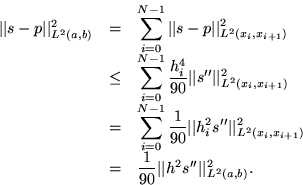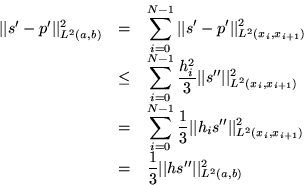For the finite element techniques we typically use piecewise
linear functions: ![]() , and the piecewise
linear interpolant p(x) of s(x) is linear on each piece
[xi,xi+1].
What we want is to bound the error e(x)=s(x)-p(x) or its derivative
in either the
, and the piecewise
linear interpolant p(x) of s(x) is linear on each piece
[xi,xi+1].
What we want is to bound the error e(x)=s(x)-p(x) or its derivative
in either the ![]() or L2 norms over [a,b].
or L2 norms over [a,b].
To obtain these bounds, we need to combine the bounds on each
piece into a bound over the entire interval.
We can't do it all in one go over the entire interval, because
![]() is not absolutely continuous across the boundaries
of the ``pieces''.
is not absolutely continuous across the boundaries
of the ``pieces''.
For the analysis, let hi=xi+1-xi. Following the textbook, let h(x) = hi for x between xi and xi+1.
We use the notation ||f||L2(r,s) to denote the L2 norm of
f(x) over the interval (r,s) or [r,s].
Similarly, ![]() is the maximum of |f(x)| over
is the maximum of |f(x)| over
![]() .
.
We start with the bound (1) for
![]()
![]()
| (11) |
If all we have is an L2 bound on ![]() , then we use
the piecewise bound (6) to get
, then we use
the piecewise bound (6) to get
| (12) |
If we wanted L2 bounds we could use (7) to get

| (13) |
We can use (9) to obtain over-all bounds on ||s'-p'||L2(a,b):

| (14) |